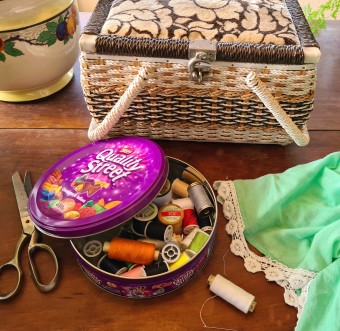 Mending… so out comes the sewing box Nanna Francesca gave me for my 8th birthday. I can’t tell you how disappointed I was to receive this as a present at that age, though I put on a happy face so not to hurt her feelings. Afterwards, I told Mum she could have it and the sewing box sat in her linen press for years. Yet, once I moved into my own house, I went and retrieved it and it has stayed with me.
Mending… so out comes the sewing box Nanna Francesca gave me for my 8th birthday. I can’t tell you how disappointed I was to receive this as a present at that age, though I put on a happy face so not to hurt her feelings. Afterwards, I told Mum she could have it and the sewing box sat in her linen press for years. Yet, once I moved into my own house, I went and retrieved it and it has stayed with me.
I’m not much of a sewer like my grandmothers and great-uncle were. I can only mend hems or sew on buttons by hand. In first year high school, when all us girls had to do ‘Home Economics’, I liked the cooking (we made scones and shepherd’s pie) but didn’t take to sewing. I think I lacked the patience and neatness needed. It was Mum, in exasperation – ‘You should at least be able to mend a hem and sew on a button!’ – who showed me.
The white thread I’m using was hers. All the other spools also Mum’s or my grandmothers’. The scissors, a bit blunt now, were Nanna Francesca’s, and Quality Street chocolates I’ll always associate with having at her house. I know I’m terribly sentimental but it’s nice to be reminded of these connections on the odd occasion I get out this old, sewing box.
Even this sundress I’m mending is old and faded but its cool cotton is perfect as a ‘house dress’ in summer. I recall women in Italy sitting on chairs outside their doorsteps, mending clothes or linens (to me, a comforting sight). Partly, such mending stems from necessity, especially in poorer areas, however in Italian folklore there’s also an awareness and valuing of the fleeting nature of certain earthly materials we use. Like linens or timbers that bear the effects of sun, wind, human treatment, rain, marks, stretches and shrinks in their histories of use and misuse. Things that may not be financially worth much, but worth being mended for as long as they may be used.
Once I would’ve been too self-conscious, but I think if I was in Italy, I’d now drag a chair outside the door while I sit and hem, catching the breeze and perhaps a chat if someone happened to stroll by… 💚🧵

 I never expected to end up with a collection of linens that span four generations of women on both sides of my family. Especially since, as a teenager, I’d hope for the latest record for my birthday only to be disappointed when Nanna Francesca gave me tablecloths ‘for my Glory box’. Again. For years these sat unused along with the tea towels, doilies and other items I also had no interest in then.
I never expected to end up with a collection of linens that span four generations of women on both sides of my family. Especially since, as a teenager, I’d hope for the latest record for my birthday only to be disappointed when Nanna Francesca gave me tablecloths ‘for my Glory box’. Again. For years these sat unused along with the tea towels, doilies and other items I also had no interest in then.